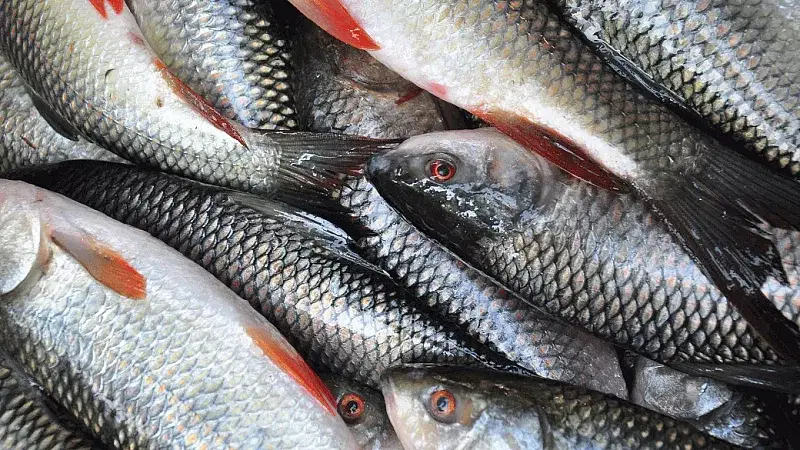
There’s a good news for the fish-loving population of Bangladesh. Bangladesh has moved up from third to second position globally in freshwater fish production. China, which was in the second position last time, has slipped to the third rank. India is on top of all in this list.
This information came up in the report ‘The State of World Fisheries and Aquaculture 2024’ on global fishery resources, published by the Food and Agriculture Organization (FAO) of United Nations Saturday. The report is based on information from 2022. This report is published every two years.
Basically, the production of fish from rivers, beels, haors and open water has been taken into account in that report. However, when counted the farming done in ponds and other water bodies Bangladesh slid two notches from third to the fifth position this time.
Bangladesh had ranked third in FAO report of 2022. Earlier than that, Bangladesh was in fifth position for five consecutive years from 2016 to 2020.
When asked, for what specific reasons Bangladesh moved ahead in freshwater fish farming Bangladesh Fisheries Research Institute (BFRI) director general Md Zulfikar Ali told Prothom Alo, “Bangladesh is protecting its open waters.”
“At the same time, from creating hilsa sanctuaries and banning hilsa fishing during the breeding season other fish varieties are also being protected alongside hilsa. As a success for these initiatives we have progressed even further in fish production,” he added.
According to BFRI records, Bangladesh has produced total 4.8 million (48 lakh) tonnes of fish last year (2023). Out of that, 3.2 million (32 lakh) was produced in farms, 1.3 million (13 lakh) tonnes was acquired from freshwater and the remaining portion was collected from the sea. Notably, half of the fish produced from the open waters was indeed hilsa. In 2023, Bangladesh produced total 650,000 (6.5 lakh) tonnes of hilsa only.
As per the records of this government organisation, there are 261 varieties of fish in the open waters of the country. The scientists at BFRI has invented artificial breeding and advanced farming methods for 40 of these varieties. In addition to ponds, planned farming of these fishes is going on in beels and rivers as well, which in turn is helping increase country’s fish production.
According to several related reports, almost 20 million (2 crore) people of this country are involved in fish farming and trading. Back in 1990, per capita fish consumption was 7.5 kg which has now reached the bar of 30 kg.

11.7 per cent of world’s freshwater fish is in Bangladesh
According to FAO report, Bangladesh produces 1.32 million (13.22 lakh) tonnes of freshwater fish which amounts to 11.7 per cent of world’s total fish production. According to the previous report, Bangladesh’s contribution was 11 per cent.
With a production of 1.89 million (18.9 lakh) tonnes, India has climbed to the top of that list this time. Meanwhile, China with a production of 1.16 (11.66 lakh) has slithered down to the third position. After China, there are Myanmar, Indonesia and Uganda in line.
The report has been prepared with the records of fish produced in every country of the world in 2022. It stated that the production of freshwater fish in Bangladesh was 440,000 (4.4 lakh) tonnes back in 1980. It rose to 1.25 million (12.5 lakh) tonnes in 2020.
Pointing out reasons behind the decline of fish produced from open water in China, the report stated that the country produced 2.2 million (22 lkah) tonnes of fish from these sources in 2017.
However, fishing in Yangtze River, one of the major sources of fish in the country was banned for 10 years in 2020. The fish resources of that river were running out due to excessive extraction.
So, efforts are being made to increase that resource again. That’s why the total fish production of China has been declining for the past two years.
It has been mentioned in the report that most of the countries in the world that are leading in freshwater and farmed fish production are from the Asian continent. Fish farming is more common in the low and medium income countries of this region.
Especially, there is a favourable environment for collecting and farming freshwater fish in China, India, Vietnam and Cambodia for there being more rivers and wetlands there. Fish is playing a vital role in creating livelihood opportunities and meeting nutritional requirement of the residents there.
In representing the overall situation of fishery resources in the world, the report stated that global fish production broke all-time records in 2022. Total 22.3 million (22.32 crore) tonnes of fish was produced that year, which is 4.4 per cent higher than that of 2020. It’s worth USD 313 billion.
Protect small and medium fish varieties also
Meanwhile, Bangladesh stood 14th in marine fish production. The country has also made quite a progress in this sector as Bangladesh’s position was 25th in the previous report. And, Bangladesh occupies the ninth position when it comes to crab farming only.
Quite a few countries have set up examples in environment protection and in waste management in case of fish farming. They are using low-cost technologies such as removing the waste through drains and other technologies for repurposing that.
Use of those technologies started from China and now Bangladesh, Vietnam, Cambodia, Mexico, Uzbekistan and Egypt are following in their steps.
The report stated that Egypt in Africa alongside Bangladesh and Vietnam in Asia has set an example in the area of increasing farmed fish production. In these countries, more than 50 per cent of peoples’ protein requirement is being met from fish.
When asked, professor Abdul Wahab of Bangladesh Agricultural University told Prothom Alo that Bangladesh has ascended to second position globally in open water fish production for taking initiative in facilitating hilsa breeding and protecting jatka (small hilsa).
However, other small and medium sized verities of fish in the haors and beels of the country should also be given protection during the breeding season. This way it will be possible to increase the production of nutritious small fish even more. Simultaneously, initiatives have to be taken to increase the production and collection of marine fish resources as well, he added.
source : prothom alo









